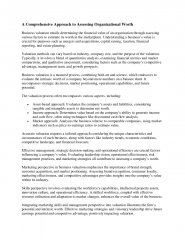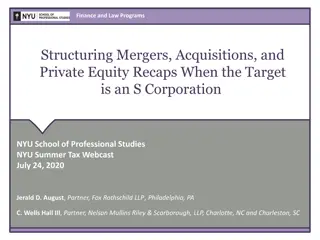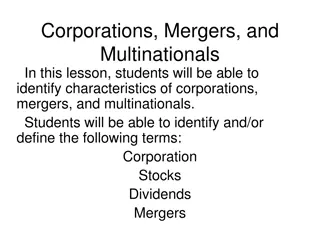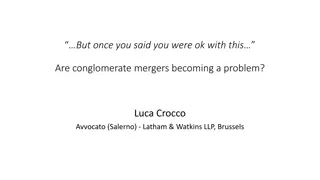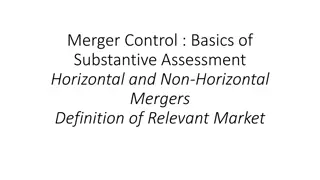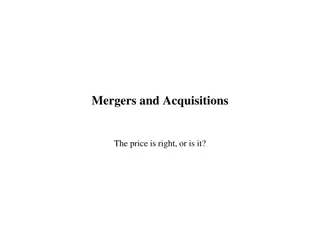Understanding Mergers in Business
Mergers refer to the integration of two or more firms under a single management. They can be horizontal, vertical, or conglomerate, each with its own strategic implications. Horizontal mergers combine competitors, vertical mergers involve firms at different production stages, and conglomerate mergers unite companies in diverse markets. The transfer of control is a key aspect of mergers, leading to increased market power or diversification.
Download Presentation

Please find below an Image/Link to download the presentation.
The content on the website is provided AS IS for your information and personal use only. It may not be sold, licensed, or shared on other websites without obtaining consent from the author. Download presentation by click this link. If you encounter any issues during the download, it is possible that the publisher has removed the file from their server.
E N D
Presentation Transcript
6.3 Mergers This term refers to the amalgamation or integration of two or more firms under different ownership and management controls come under a united one through merger. The terms acquisition and takeover are also used for merger , which implies that a firm acquires assets or stocks in part or full, of other firm(s) to get operational control over them. In legal sense, there is a difference between these terms but from the point of view of the economic analysis they are similar. The important feature of merger, that is relevant to us, is the transfer of control of business activity from one or more firms to another.
6.3.1 The Nature of Merging The words merger and acquisition are used interchangeably. If the distinguished, then a merger occurs when two or more firms are voluntarily combined ownership, while an acquisition, or takeover, occurs when one firm acquires or buys the assets of another without the agreement of the controllers of the target company. 6.3.2 Types of Mergers Economists have identified three types of mergers formed by firms. These are: horizontal mergers, vertical mergers and conglomerate mergers. two terms are to be under common
Horizontal mergers occur when two firms in the same market or direct competitors and the same geographic market are consolidated into a single enterprise; this means that This type of merger is designed to acquire market power as the new enterprise will have increased its market share.
Vertical mergers involve firms that produce at different stages of production in the same industry. Vertical mergers take place between firms, which engage in successive stages of production such as brewing and running public houses; so both upstream (backward) or downstream (forward) are possible. The output of one stage of operation serves as an input or market outlet to the other stage.
Conglomerate independent products for different markets are merged. Conglomerate mergers involve companies that operate in either different product markets or the same product market but different geographic markets. Conglomerate mergers are usually subdivided in to three types: Product extension mergers between companies that produce different but related products (e.g., laundry detergent and liquid bleach); Geographic extension mergers between companies that produce the same product in different location (e.g. a Midwestern beer producer purchases a north eastern beer producer); and Pure conglomerate mergers between firms operating in entirely separate markets (e.g., a telephone company purchases a rental car company.) Conglomerate mergers create larger diversified firms. mergers occur when two firms producing
Types of mergers will vary according to the nature of the industry and the degree of fragmentation. In a sector like legal services, the vast majority of mergers will be horizontal because there are large numbers of small law practices that are currently consolidating. Some may be of a conglomerate nature in that firms in different industries may merge (e.g., legal and accountancy firms). In other industries that are more concentrated but have strong vertical linkages, mergers are less likely to be horizontal in nature and more likely to involve vertical integration.
6.3.3 Motives for Merging Several major advanced to explain mergers. Seven of the most commonly advanced discussed below. reasons are commonly reasons are
a. Market power All three types of mergers can increase market power. Horizontal mergers are more likely than either vertical or conglomerate mergers to have serious anti competitive effects b/c horizontal concentration, the possibility exists that market power will increase. Vertical mergers may result in increased entry barriers, particularly the capital barrier, or an increased likelihood of collusion. Finally, although other negative effects are possible, the most likely negative impact of a conglomerate merger is a reduction in the level of potential competition. mergers always increase
b. Efficiency gains. Mergers are often motivated by a desire to increase economic efficiency, and some mergers result in significant efficiency gains, economies of scale may result from any merger but are most common in horizontal mergers. A horizontal merger may enable the consolidated firm to reduce its production or marketing costs. Vertical mergers also may result in real economies by reducing the transactions coordinating the different stages of production, and conglomerate mergers may improve efficiency by taking advantage of synergies in production or distribution. costs associated with
c. Financial Motives. A motive for merger may be speculation that the whole is worth more than the sum of its parts. When a large conglomerate is on a roll of good purchases, its stock value will rise, and so will its price learning s ratio. If this successful conglomerate purchases another profitable company with a lower price/earnings ratio, and finances the purchase by exchanging its stock for the stock, that is, if the conglomerate pays more than the stock is worth on the open market. In addition, the owners of the conglomerate gain because earnings per share rise when the acquired firm s profits are added to the conglomerate s profits.
Suppose for example that a large conglomerate firm, hypothetically named ABCD, has a price/ earnings ratio for its stock of 20, but a small target firm, hypothetically named WXYZ, has a much lower price/earnings ratio of 10. If the annual profits (earnings) of WXYZ are 10 million, then its current stock value is 10 x 10 million = 100 million. If the annual profits of ABCD before the merger are 500 million, its stock Value is 20 x 500 million = 10 billion. If ABCD acquires WXYZ, ABCD S earnings rise to 510 million and its stock value rises by 200 million to 10.2 billion. Suppose ABCD offers to pay 125 million for WXYZ. The WXYZ stock holders receive 25 million more than the stock is valued by the stock market, and the stock holders of ABCD still come out ahead the price of 125 million is considerably below the 200 million increases in the value of ABCD S stock.
There is also other financial motive for merger. Paid out corporate profits are taxed twice first, as corporate profits, and then as individual income there is an incentive for firms to retain profits and reinvest these retained profits in ways that lower their stock holders personal income tax burden. If retained earnings are used to acquire companies, and the acquisition result in an increase in the conglomerates and the acquisition result in an increase in the conglomerate s stock value, then capital gains result. Capital gains are taxed at a lower rate than other types of personal income and therefore, it is preferable form a tax stand point to receive income in the form of capital gains rather than as distributed corporate profits
d. Risk Reduction. It is often argued that mergers, particularly conglomerate mergers, reduce risk, and there is some truth to the old saying: It is foolish to put all your eggs in one basket. That is it is important to realize that diversification by a firm lowers the firm s risk, but individual investors can always select their optimal combination of returns and risk by diversifying their investment holdings. For a merger to reduce risk, the acquiring firm s profits must not be perfectly correlated with the acquired firm s profits. Although this technical condition is met in most mergers, a merger will not reduce risk significantly if the acquired firm operates in an industry that is highly interdependent with the acquiring firm s other business activities. In the case of considerable interdependence, when one part of the acquiring firm s business flounders, so will the acquired part.
Pure conglomerate mergers are the most likely mergers to reduce risk. Few horizontal, vertical, product extension or geographic extension mergers significantly reduce risk, however, because they usually involve markets that are interdependent with the firm s other operations. If two coal companies merged and then the market for coal became depressed, both firms would suffer, and the merger would have done little to reduce risk. e. Empire Building: A factor encouraging some mergers is the desire of an individual to build a financial empire. Strange as it may seem, many mergers are primarily the result of an individual s effort at self aggrandizement.
f. Failing Firm A firm on the verge of bankruptcy may attempt to find a buyer to bail it out. Few large mergers appear to be motivated by the existence of a failing firm g. Aging owners. In some cases, a motive for merger is the age structure of the company s ownership. If a company is privately owned or controlled by an individual without heirs, or with out heirs who have a desire to operate the business, then the owner will sometimes search for a buyer. A merger permits the owner to retire on the anticipated future earnings of the firm because these earnings are capitalized in to the present value of the firm.



